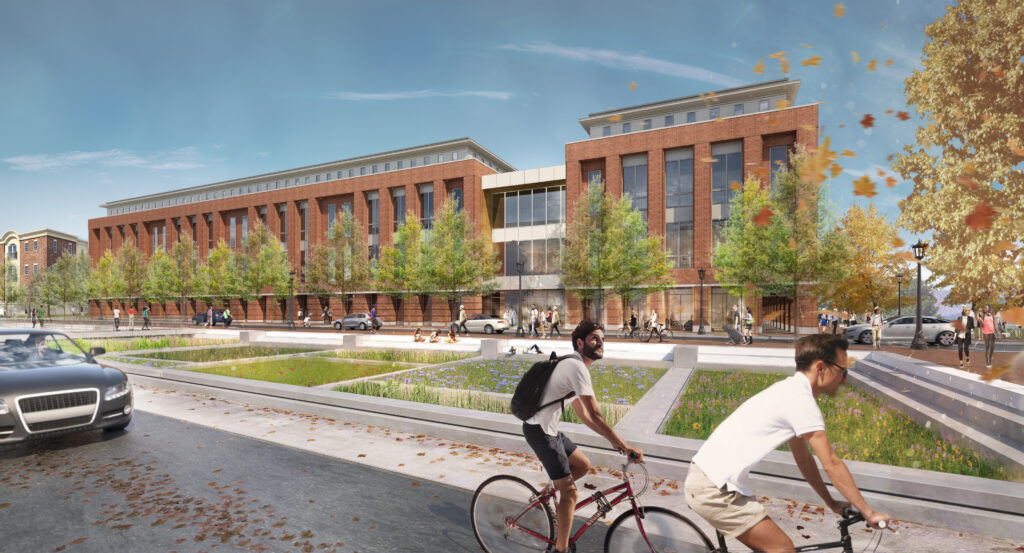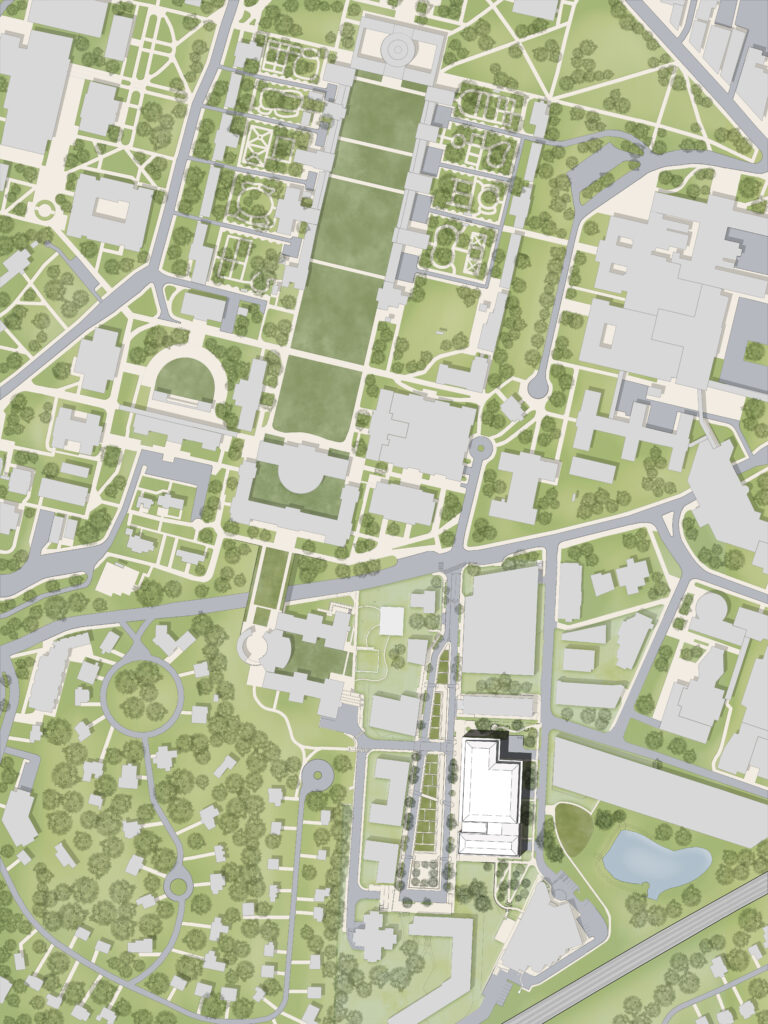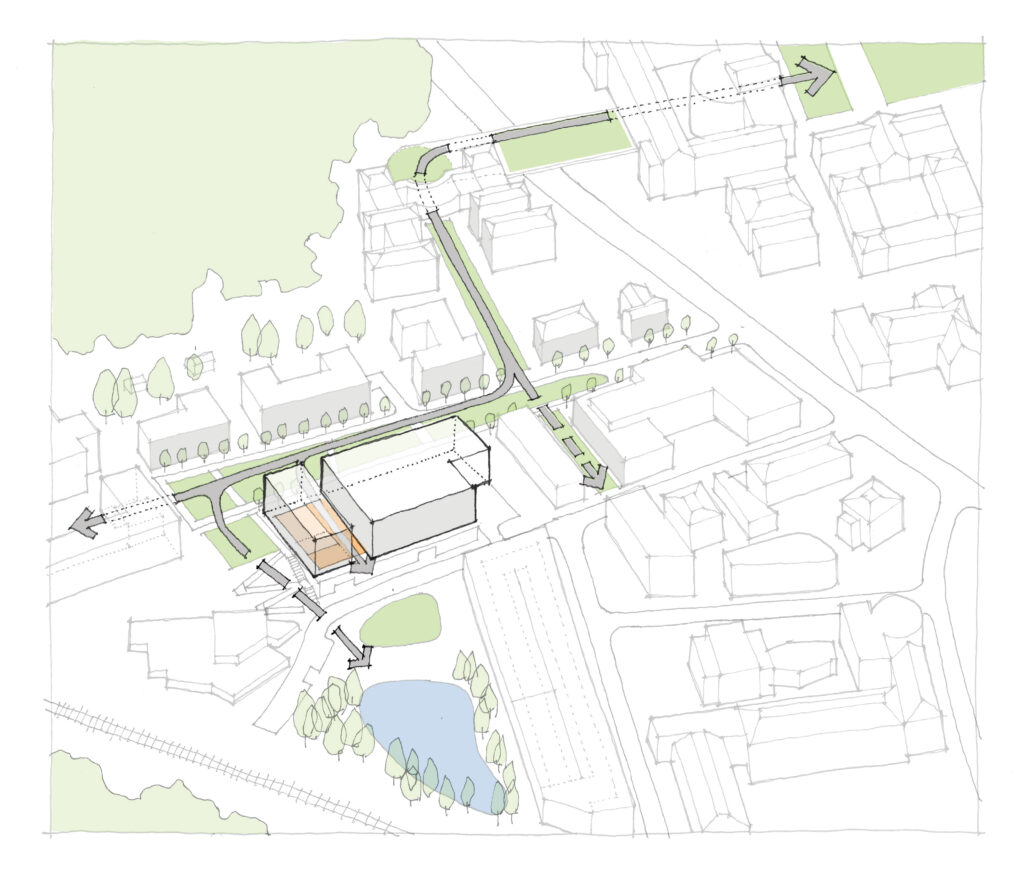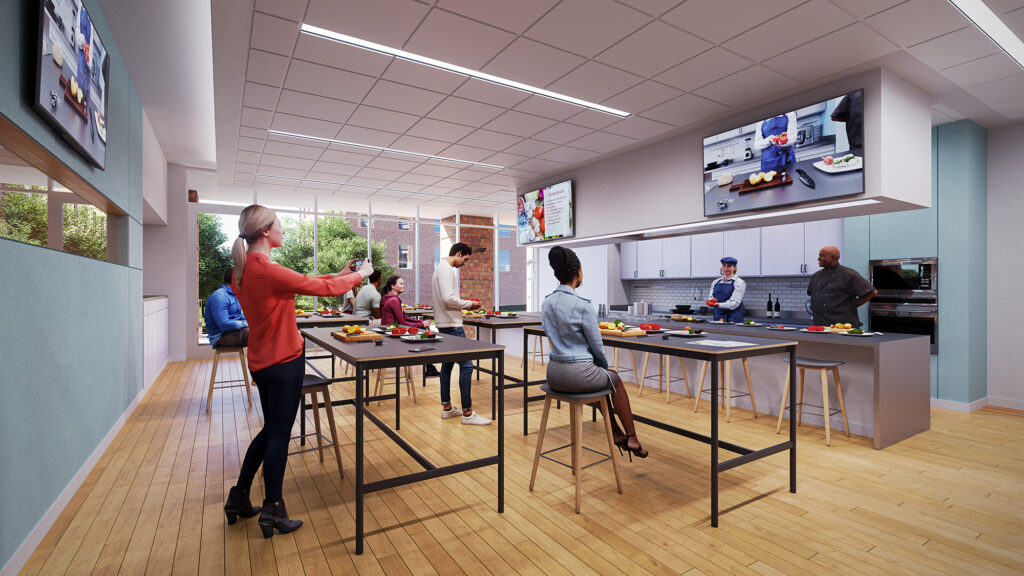
As students return to campus amid continued pandemic uncertainty, awareness of the importance of good health — physical, mental, and emotional — is intensifying. Attending college can be stressful under any circumstance. Aside from the rigors of academic life, it is often a student’s first time living away from home. For universities looking to develop health programs to address the needs of today’s students, the new Student Health & Wellness Center at the University of Virginia presents a model that expands traditional health services and facilitates a new approach to student wellness with preventative practices and strengthened community connections.
Whole-body Collaborative
UVA envisioned a welcoming, highly accessible facility to combine holistic healthcare with education programs, resources to serve healthy students, and research. All would be fostered in an environment of collaboration and information sharing among disciplines. This visionary union of student life, health, and well-being would also nurture a strong sense of community and social interaction — both important contributors to students’ sense of belonging.
UVA entrusted the project to the design collaboration of Virginia firm VMDO Architects and wellness experts Duda|Paine Architects (Durham, North Carolina). Higher education specialist VMDO has a portfolio of successful housing, academic buildings, and health centers. Duda|Paine Architects has been at the vanguard of rethinking architecture for wellness. The firm was one of eight to receive a 2020 AIA Healthcare Design Award for the Duke Student Wellness Center at Duke University.
UVA’s Office of Health Promotion played an active role in programming spaces centered on well-being, while Counseling & Psychological Services (CAPS), Student Disability Access Center (SDAC), General Medicine, and Kinesiology were all essential contributors. All of the departments are under the Student Health umbrella, except the academic program of Kinesiology. Placing these functions together under the same roof represents a unique partnership with a university amenity sharing space with an academic department to facilitate collaboration and research. The project was led by Christopher P. Holstege, MD, the Executive Director of Student Health at UVA and his holistic vision for the new facility.
The design team hosted on-campus feedback sessions and intensive workshops with students, staff, and faculty. Virtual reality simulations and walk-throughs allowed stakeholders to recognize the center’s potential as a truly shared facility. Student insight led to unique features including student-run activity spaces, gender-neutral bathrooms, interactive environmental graphics, and the design of the “Oasis” well-being space.

Building Connection
The marriage of architecture and landscape has always been an essential characteristic of UVA’s campus. The building site — already under development and near the existing center — was chosen to bridge between the campus’s central grounds and the UVA Health System campus. With proximity to the historic Academical Village, the site also included the potential for unobstructed views to surrounding mountains. Special attention was given to stitching connections to campus circulation routes from all four façades. The entry level lobby was envisioned as an internal street to connect a new district along Brandon Avenue to the South Pond at the building’s east. The design’s integration with the landscape creates outdoor amenities for building users and the campus community.
VMDO’s design of the exterior architecture supports UVA’s vision for the new, semi-urban, pedestrian-oriented Brandon Avenue. The massing of the project’s 170,000 square feet was carefully restrained to three stories plus a shorter “attic” fourth story and nestled into a slope to help the scale feel contextual and pedestrian friendly. Its elevations pick up on classical hierarchies present in UVA’s existing architecture, while generous expanses of glass, deep balconies, shaded porticos, and a transparent lobby speak to the project’s modern interior. The rhythm of the brick exterior incorporates large expanses of glass aligned with activities and programs within, including the configuration of medical pods on upper levels.

At ground level, extensive glazing and continuous flooring extend Brandon’s pedestrian-friendly streetscape and draw students into a two-story entry. This space is the first stop for students seeking to use the center’s many resources; it is also where the building’s mission to increase awareness of health services and well-being converge.
A guiding principle of Duda|Paine’s programming and interior design was to offer students choice and establish circulation patterns that ensure the center’s resources and services are highly accessible.
The building’s organization is anchored by two 2-story spaces: the entry at Brandon Avenue and a second floor waiting area with long views to the South Pond and mountains beyond. Visual connections between floors and out to campus through windows at corridor ends serve multiple purposes. They provide natural light as well as views of campus that aid navigation to the building’s diverse programs. Wood ceilings in circulation spaces also help orient users moving through the building.

Just off the first-floor main lobby is the central “living room.” Couches, varied seating configurations, and a fireplace encourage students to stop, lounge and socialize. The upper lobbies are stacked above, connected by a curved mosaic wall of blue, green, and frosted white glass tile that wraps the main staircase. These spaces become more student-centric, with increasingly adaptable furnishings, as one rises through the levels. Every department has its front door off a lobby space for easy wayfinding. Gracious waiting areas for care are configured for comfort and privacy. Floor-to-ceiling windows on two sides allow users generous views to campus and the mountains beyond.
Establishing connections to nature is fundamental to fostering wellbeing. The center fulfills this ideal with lounges and waiting areas that offer generous views of the surroundings. Material choices, color, finishes, and extensive natural light also reflect nature. The result is an environment more like home than a traditional clinic — one that invites students in and encourages their engagement.
A Convergence of Programs
The Office of Health Promotion and the entire Student Health system at UVA wanted the new center to elevate access for students of all abilities and backgrounds — from first generation university to international — and to help educate all students, most of whom are managing their own healthcare for the first time, about what good healthcare can look like. The transparent architecture and daylit interiors foster awareness of the diverse care offerings including for mental health issues and addiction. Within are the core units of General Medicine, Counseling and Psychological Services (CAPS), the Student Disability Access Center, and the UVA Health System’s satellite pharmacy and laboratory. The department of Kinesiology and accompanying gym on the third floor will provide state-of-the-art labs for Kinesiology research and enable collaborations with Student Health. The Oasis is highly flexible with comfortable lounge pieces, bean bags, and other adaptable furnishings, reconfigurable to support individual and group activities. Adjacent greenspaces allow outdoor options for students and staff as well.

Beyond standard clinical spaces, the center includes a teaching kitchen, meditation rooms, a lactation room, an addiction recovery clubhouse, and dedicated relaxation, movement, and art therapy spaces. By putting mind-body programs at the forefront, the design addresses, supports, and destigmatizes critical issues for student populations predicted to be on the rise as students return this fall, including anxiety, depression, and substance abuse. The design also supports a broader mission of increasing capacity and visibility so UVA’s growing student population can take full advantage of UVA’s free university healthcare.
Sustainability and Resilience
The project explored relationships between climate action, human health, and ecosystem restoration. As part of the Brandon Avenue’s Green Street, the design supports a district-wide approach that captures, cleanses, and slowly releases site stormwater using green infrastructure. The building’s materials were selected for transparency, climate impact, and effects on occupant health. High efficiency HVAC systems, including chilled beams and dedicated outdoor air systems, provide fresh air, excellent filtration, and, when coupled with an enhanced building envelope, deliver a 49% energy savings compared to the LEED baseline model, helping UVA to meet its carbon neutral targets. The building is photovoltaic-ready, and plans are in progress for installation of an array after construction completes through a power purchase agreement (PPA).
Encompassing issues of urban-scaled planning, design for comprehensive care and prevention, and strategies to reduce environmental impact, UVA’s new Student Health & Wellness Center presents a holistic, student-focused, community-centric way forward for universities to rethink and reshape the future of student wellness.
About the author
Rebecca W.E. Edmunds, AIA, LEED AP is president of r4llc, a writing, branding and design consultancy based in Roanoke, Va.
Contributors:
Lauren Shirley, AIA, LEED AP, WELL AP; Associate, VMDO (Architect of Record)
Scott Baltimore, AIA, Senior Associate, Duda|Paine Architects (Programming and Interior Design Architect)
